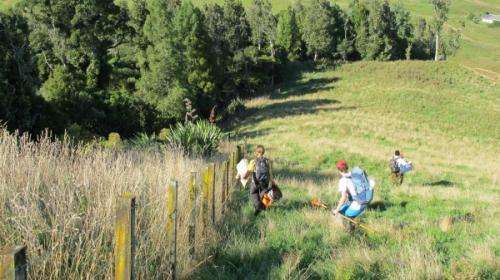Increased farming intensity links to nutrient spillover

Farmers lose more nutrients into adjacent land as they increase farming intensity, research has found.
A study measuring the spillover effects of farming inputs on adjacent forest remnants has found a linear relationship between agricultural intensity and cumulative levels of nitrogen, phosphorus, uranium and cadmium in neighbouring forest soils.
UWA Professor of Ecology and CSIRO researcher Raphael Didham says the findings are challenging, but could lead to a win-win for farmers and the environment.
"Farmers don't want to be losing nitrogen off their paddocks into adjacent waterways or forests; fertiliser is expensive, they'd like to use it efficiently for production," he says.
"This lost nitrogen is basically an inefficiency in the production system. If farmers can make their systems more efficient, and reduce spillover, then their profits will be higher and environmental damage will be lower."
Prof Didham's team measured 13 variables of soil biochemistry and farmer inputs across 21 farms, 21 forest remnants and three reference forest reserves in New Zealand's Waikato region.
"We randomly selected farms across a range of farming systems—sheep, beef, dairy—and then we measured a range of farmer inputs, things like fertiliser and lime, and took soil samples," Prof Didham says.
The team found using fences to prevent livestock from entering adjacent forest reduced but did not eliminate nutrient spillover, recording pervasive spillover effects up to 50 metres beyond fenced boundaries.

Agricultural intensification is seen by some as a way to conserve forests, but Prof Didham says even localised changes to forest soils can have flow-on effects on ecology and biodiversity.
"Higher nitrogen and phosphorus cause greater growth of weeds, which outcompete native grasses and native flowering plants, for example," he says.
"Once you exceed the soil saturation point for holding nitrogen, then you'll get greater and greater amounts of nitrogen leaching into waterways, eutrophication of rivers and lakes [excessive nutrient richness], and impacts from those flows into the ocean, which has been seen in Europe, where they've had a much longer history of intensive farming."
Prof Didham says the findings have implications for Australian agriculture and conservation.
"Here in Australia there's a big move towards precision agriculture, which targets inputs much more carefully, inputs of fertiliser, also inputs of water...inputs of labour, time, everything that goes into a farm.
"If you're more precise about that, and target inputs to areas where you can make the greatest profit, while minimising impact on the environment, then everybody wins."
More information: Didham RK, Barker GM, Bartlam S, Deakin EL, Denmead LH, et al. (2015) "Agricultural Intensification Exacerbates Spillover Effects on Soil Biogeochemistry in Adjacent Forest Remnants." PLoS ONE 10(1): e0116474. DOI: 10.1371/journal.pone.0116474
Journal information: PLoS ONE
Provided by Science Network WA



















